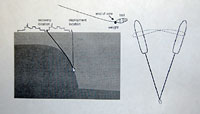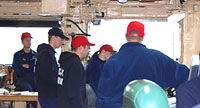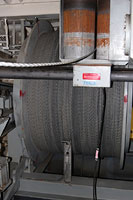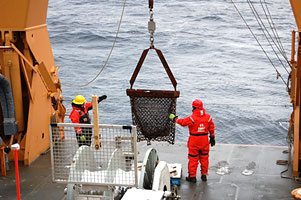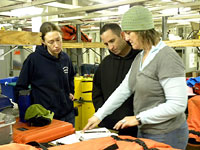

 | |||||||||||||||||||
|
|
Journals 2009/2010Jonathan Pazol
September 7, 2009 Happy Labor Day! With the exception of our recent festivities, the Healy is a 24/7 operation, so it was back to business as usual (almost). Because of the holiday, the crew still had to stand watch but did not have any of their extra daily duties. Breakfast and lunch hours were also extended by an hour, so it gave people time to sleep-in and to relax. For part of the Science Party, the MSTs (Marine Science Technicians), and some of the rest of the crew this afternoon became very busy, as we prepared to dredge. In this operation, dredging is where a heavy-duty, open, metal frame (dredge) and metal net assembly (held onto the winch wire by a u-shaped bar called a bail) is lowered at the end of a long wire straight down over the fantail (rear of the ship) and down to the sea floor. This is done just to one side of an undersea ridge. The ship then moves forward, so that the bail is then dragged up along the steepest slope of the ridge. It is done this way in order to collect rocks that have not been covered by sediment (mud). By studying the rocks, geologists can help figure out the composition, age, and history of the ridge.
To be ready for the dredging operation, Chief MST Mark Rieg prepared a 5 page Mission Plan. In typical Coast Guard fashion, this plan covers all possible operational steps and emergency situations. It incorporates such things as a mission definition, characteristics and breaking strengths of all the equipment and wires, environmental conditions, hazards, options, and a risk assessment. Potential hazards include things such as getting the dredge stuck on the bottom to losing all power, and covered the severity, likelihood, and number of times each of these could occur. The Mission Plan also outlines the options and steps that could be taken should a problem arise. Captain Sommer, as well as the heads of all the major involved departments, the MSTs, and Science Party personnel participating in this "evolution" (operation) met for a briefing. During the meeting, the GAR (Green, Amber, Red) Risk Assessment score was reviewed. Looking at things such as supervisor capability, crew experience and fitness (includes the amount of sleep crew members have had), event complexity, planning, equipment, and environment, this dredging evolution was given a composite score of 34 (Amber). On a 10 point scale in 7 categories, the ratings are as follows: 0-27 Green (low risk), 27-51 Amber (caution), and 51-70 Red (high risk).
Once the meeting was concluded, the operation was ready to begin. Announcements were made over the pipes that certain aft (rear) portions of the ship were off-limits because of the high-tension in the wires. Should the 9/16" wire snap, it would act like a giant rubber band, swinging back up onto the ship with a tension of 32,000 pounds - enough force to rip metal frames off the deck, shoot through the bulkhead, or easily kill someone. Control of the Healy was transferred to the Aft Conn, so that steering, motor operation, and dredging could all be done from one location. The dredge was attached to the 4 kilometer (2.4 mile) long wire, and the winch on the a-frame was used to lower it into the ocean.
Dropping at a speed of 50 meters (about 163 feet) per minute, the dredge was going to take several hours before it reached the sea floor 3850 meters (2.3 miles) below. In the meantime, the geologists prepared the participating Science Party members for the recovery.
|
||||||||||||||||||
